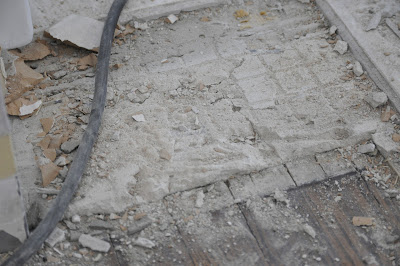I'm really excited to share part 2 of my DIY herringbone hardwood floors series. In my last post, I went over buying, acclimating, and cutting your wood to make herringbone floors.
Before I continue, I think it's important that I outline the difference between a herringbone and chevron pattern. They seem fairly similar at a first glace, but they're actually quite different, and the installation techniques are likely pretty different as well.
This image from plentyofcolour.com perfectly illustrates the difference:
The first image represents a chevron pattern - all of the pieces meet together at a 45 degree angle.This means that all of your cuts need to be cut on an angle.
The second image represents herringbone. Your pieces meet each other on the sides, which means you do straight cuts everywhere, except where you meet the walls. Aesthetically, I'm just a much bigger fan of herringbone - it seems more old style Parisian to me. But chevron is lovely too.
Where to begin when installing herringbone
The first thing you need to do, after cutting your boards, is to determine the center line that your flooring will line up with. With herringbone, the center line isn't quite as obvious as with chevron, but once you get the hang of finding it, it's not hard.
We figured out the center of our kitchen, and marked it off using a chalk line.
(there's only one chalk line on the floor, the other line you see is the chalky string above!)
Next, Joel and his dad cut a triangle corner off of a piece of plywood. They used this triangle to make sure that the boards met consistently at a 90 degree angle. They began by screwing the triangle into the floor (lining it up with the chalk line in the center) so that it wouldn't budge when they pressed the boards up against it. They started about 6 inches away from the wall, because that wasn't a perfectly straight line, and they didn't want to even risk the floor going off a little bit.
The next thing to do was to nail in the boards! We didn't use glue at all, because our boards were long enough to nail into twice per board. This totally held them in firmly enough.
How to keep the boards straight?
One trick we found was to slide a spare piece beside the board you are nailing, pushing it in as you nail, so that the boards don't slip even a smidge out of place.
These parts of the installation go quite quickly - as long as you remain square, installing the straight line parts are fast. The difficult part comes when you get to the edges of the room - this is where you have to make weird cuts to fit everything in (I'll get to that in my next post!)
That's all for now! It's crazy looking back at these pictures. Our floors are now FINISHED and I am just so excited to share them with everyone. It was a crazy, insane amount of work, but I promise, it was so so worth it.
To see my first post about DIY herringbone floors, click here.
















































